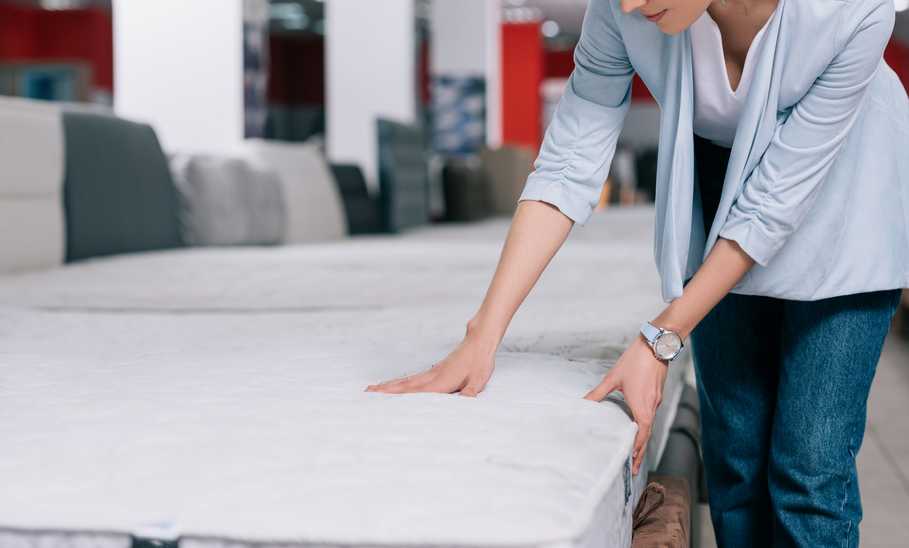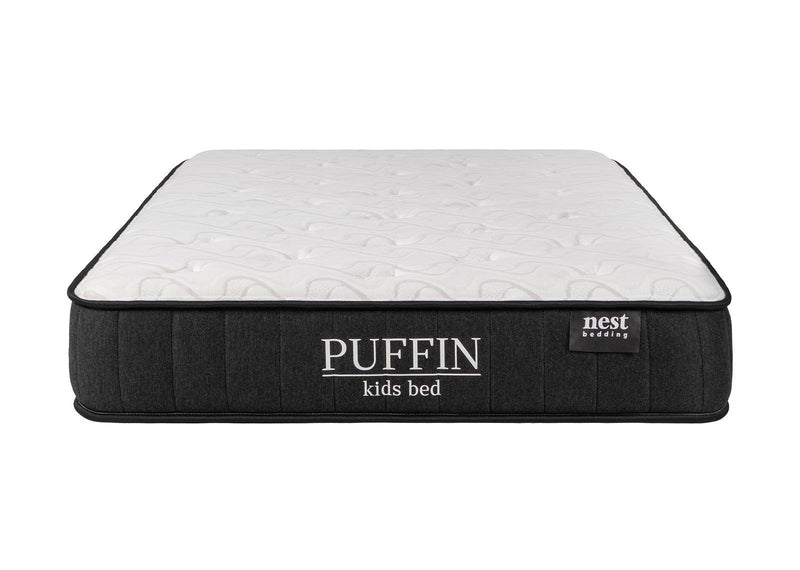How to Choose a Mattress: The Ultimate Buying Guide

Our evaluations and opinions are not influenced by our advertising relationships, but we may earn a commission from our partners’ links. This content is created by TIME Stamped, under TIME’s direction and produced in accordance with TIME’s editorial guidelines and overseen by TIME’s editorial staff. Learn more about it.
Buying a new mattress can be intimidating. Where do you start when there are so many options? It’s one of the largest and most important home expenses you’ll shell out for in a decade—and you’ll spend a third of your life on it. So, the stakes are high. In this article, we'll explore all the factors you need to consider when purchasing a new mattress, from firmness level and material, to sleeping positions and body types.
When it comes to mattress types, there are a few options, including innerspring mattresses, memory foam mattresses, latex, airbeds, and hybrids. Each offers benefits and drawbacks to consider when you’re choosing the right bed.
Innerspring mattresses: Innerspring mattresses are the most popular type of mattress and feature a support system made with steel coils. These mattresses provide an excellent mix of comfort and support, and they also tend to be more affordable than other types of mattresses.
Memory foam mattresses: Memory foam mattresses are increasingly popular due to their superior comfort. They offer great support and contour to your body for a personalized sleep experience. Memory foam mattresses also tend to be more expensive than innerspring beds.
Latex mattresses: Latex mattresses are made from natural or synthetic rubber and provide moderate motion isolation. Less expensive than memory foam, organic latex mattresses are also hypoallergenic, making them a solid choice for those with allergies or sensitive skin.
Airbeds: Airbeds are similar to innerspring mattresses, but feature adjustable air chambers instead of coils. These beds allow you to customize the firmness level of your mattress by adding or removing air from each chamber. They tend to be more expensive than other mattress types.
Hybrids: Hybrid mattresses combine two or more different materials. These beds usually feature coils, memory foam, and latex layers for superior comfort and support. They’re also often less expensive than other types of mattresses.
When choosing a mattress, there are several factors to consider. These include firmness level, material, sleeping position, body type, budget, and more.
Firmness level refers to how hard or soft the mattress feels when you lie down on it. The right firmness level for you will depend on your individual preferences and body type. Generally, side sleepers should choose a softer mattress, while back and stomach sleepers are better suited to a firmer bed.
Here is a firmness chart to help you better understand the right level for you:
| Firmness Scale | Firmness Level | Best For |
|---|---|---|
2 | Extra Soft | Side sleepers <0 pounds |
3 | Soft | Side sleepers <0 pounds |
4 | Medium Soft | Side sleepers <0 pounds |
5 | Medium | Back and side sleepers 130-230 pounds |
6 | Medium Firm | Sleepers 130-230 pounds and Side sleepers >230 pounds |
7 | Firm | Side sleepers >230 pounds and back & stomach sleepers >130 pounds |
8-9 | Extra Firm | Back & stomach sleepers >230 pounds |
Must Read: The 14 Best Places to Buy a Mattress Online
The material of the mattress is also an important factor to consider. Innerspring mattresses offer great support with their steel coils, while memory foam beds provide superior comfort. Latex beds are ideal for those with allergies or sensitive skin, while airbeds are great for couples who need an adjustable firmness level.
Your sleeping position can also help you determine which mattress is right for you. Side sleepers should look for a softer mattress that helps relieve pressure on their hips and shoulders. Back and stomach sleepers should look for a firmer mattress to help keep their body aligned. Combination sleepers should look for a mattress with good motion isolation and support.
Your body type also plays a role in choosing the right mattress for you. Heavier people are better suited to firmer mattresses with more support, while lighter individuals may prefer softer beds that provide more cushioning.
The cost of a mattress can range from hundreds to thousands of dollars, so it’s important to set a budget before you start shopping. Knowing what type of mattress you want and how much you’re willing to spend can narrow down your options and facilitate the shopping process.
Here is a pricing chart to better understand the average price range based on mattress types.
| Mattress Type | Price Range (Queen Size) |
|---|---|
Foam | $900-1300 |
Innerspring | $600-1100 |
Hybrid | $1500-2000 |
Latex | $1600-2000 |
Airbed | $2000-2400 |
Mattresses come in a range of sizes, from twin to king. Choosing the right size for your bed frame and sleeping needs is important. Twin and full sizes are great for children, while queen and king sizes provide more space for couples or those who toss and turn at night.
Related Read: A Comprehensive Guide to Mattress Sizes and Bed Dimensions
Most mattress stores offer free delivery and setup. However, you should always double-check the company’s shipping costs and timeframes, factoring any additional delivery costs into your overall budget.
Finally, it’s important to read the mattress store’s return policy before you buy. Many companies offer a sleep trial period or money-back guarantee if you don’t like your mattress after sleeping on it for a few weeks. This allows you to ensure your bed is perfect for you before committing.
For those with specific sleeping needs, there are even more things to consider when mattress shopping. People with back pain should look for beds with additional support and cushioning. Those with allergies or sensitive skin may benefit from a latex mattress since it’s hypoallergenic and dust mite-resistant. Children may need more durable mattresses, while couples should look for beds with adjustable firmness levels or motion isolation technology.
When it comes to buying a mattress for a child, parents should consider the same factors as when choosing an adult mattress. However, there are a few additional considerations:

If you suffer from chronic back pain, choosing the right mattress is key. helpful. Mattresses should provide enough support and enough cushioning to provide comfort.
Materials: Look for mattresses that use high-quality materials like latex or memory foam—they’ll provide the best support and pressure relief.
Firmness level: A medium-firm mattress is recommended for those with back pain. This provides the optimal balance of support and cushioning. If you find yourself sleeping better on a softer mattress, look for one with adjustable firmness levels so you can customize the feel to your needs.

For those with allergies or sensitive skin, it’s important to choose a hypoallergenic and dust- mite-resistant mattress.
Materials: Latex mattresses are the best choice for those with allergies, since they’re naturally dust-mite resistant. Memory foam may also be a good option, as some mattresses are treated with anti-allergen coatings.
Firmness level: Hypoallergenic mattresses are available in a variety of firmness levels, so your personal preference should be your guiding consideration here.
If you’re looking for an extra layer of cushioning and support, try a mattress topper. They come in various materials, including memory foam, latex, down, and wool.
Materials: Memory foam is usually the best option as it provides superior comfort and pressure relief. Materials like down and wool may be suitable for those who prefer a softer feel.
Thickness: Choose a mattress topper at least two inches thick for the best comfort and support. Thinner toppers may not provide enough cushioning or support, while thicker ones may be too soft.
Firmness level: For the best balance of comfort and support, look for a topper that’s medium-firm or slightly firmer. Softer toppers may not provide enough cushioning, while too-firm ones may be uncomfortable.
When it comes to buying a mattress, there are many options available. You can buy online, in-store, or even rent one from a mattress rental company.
The mattress should fit snugly on the frame and not sag. Be sure to measure the bed frame before buying your mattress so you know what size will fit best. Also, take into consideration the height of the bed frame when choosing a mattress, as some may be too high or low for certain frames.
It depends on your individual preference and sleeping position. Generally, a medium-firm mattress offers the best balance of comfort and support for most sleepers. Those with back pain may prefer a firmer mattress, while those who need extra cushioning may find a softer mattress more comfortable.
Memory foam mattresses are usually the most comfortable option, as they provide superior cushioning and pressure relief. Latex mattresses may also be a good choice for those who prefer a more natural feel.
Thick mattresses can provide more cushioning and support than thin ones, but they may also be too soft for some sleepers. The best choice depends on your needs and preferences. Generally, a mattress that’s at least two inches thick is recommended for the optimal balance of comfort and support.
This depends on your needs and preferences. Online shopping offers the convenience of comparing prices and reading customer reviews from home, while in-store shopping allows you to try out different mattresses in person and get advice from knowledgeable sales staff. Ultimately, the best choice will depend on your budget and personal preference.
Yes, mattress toppers are typically thicker than pads and provide more cushioning and support. Pads are usually thinner and designed to protect the mattress from spills or stains. Toppers can be used for extra comfort, but they’re not as effective at protecting the mattress.
This depends on your needs and preferences. Foam mattresses provide superior contouring and motion isolation, while spring mattresses tend to be more supportive and responsive. Ultimately, the best choice will depend on your budget and what type of mattress you find most comfortable.
It depends on the type of mattress and bed frame you have. Generally, box springs aren’t required for foam or latex mattresses, as they tend to provide enough support on their own. If your bed frame is slatted or has an open base, you may need a box spring for more stability and support.
It depends on the type of mattress you have. Traditional innerspring mattresses should be flipped every few months to ensure even wear and prevent sagging. However, foam and latex mattresses are usually one-sided and do not need to be flipped.
Yes, many mattresses come with a warranty that covers manufacturing defects for up to 10 years. Warranty length and terms will vary by manufacturer. Be sure to read the manufacturer’s guidelines carefully to understand what’s covered and for how long the warranty is valid.
At the end of the day, when it comes to choosing a mattress, there’s no one-size-fits-all solution. Everyone’s needs are different and understanding those needs will help you make the best choice for your comfort. By taking into consideration all of the factors discussed above, you can ensure your mattress is the best fit for your preferences and sleeping habits.
The information presented here is created by TIME Stamped and overseen by TIME editorial staff. To learn more, see our About Us page.



